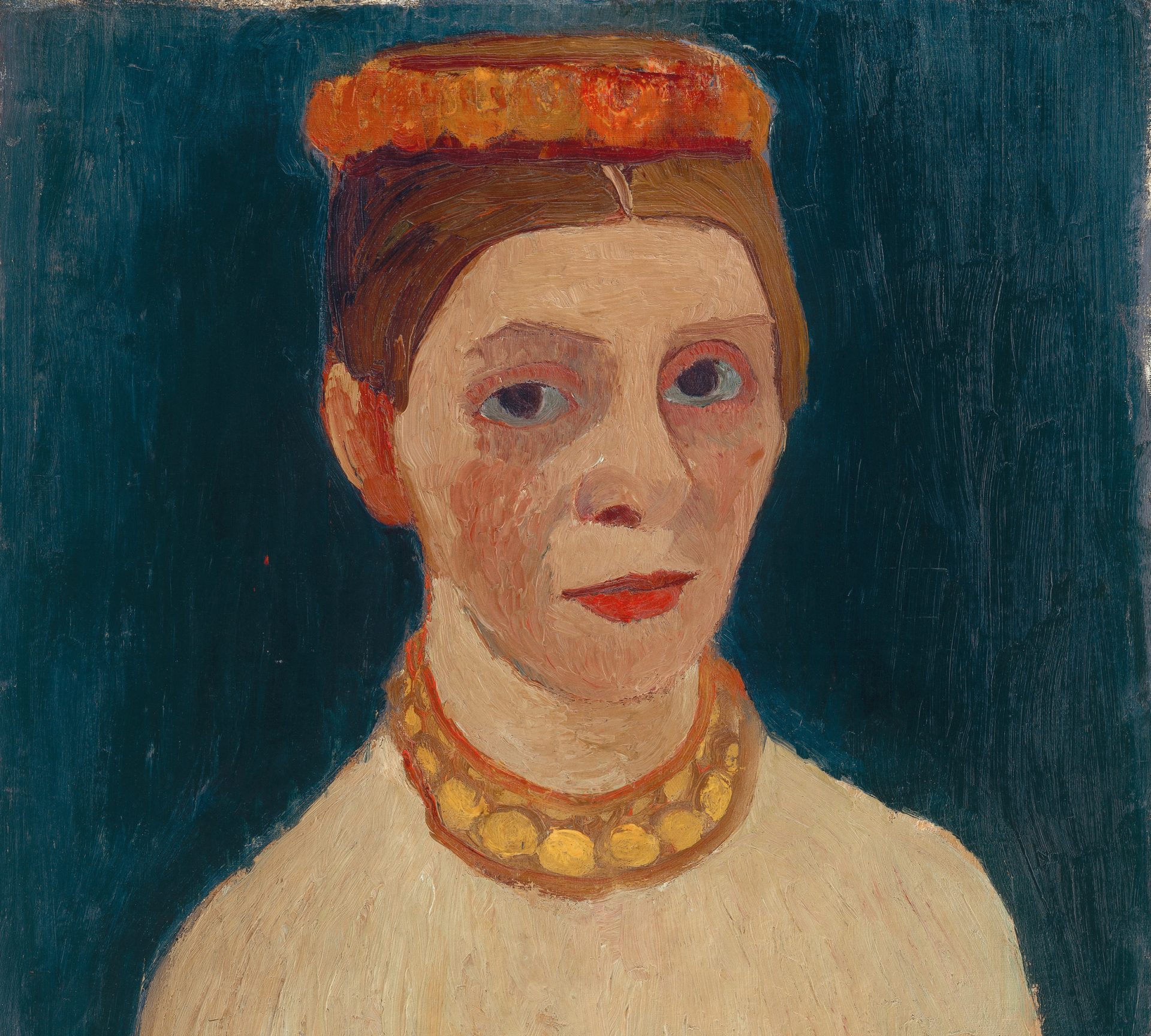When Paula Modersohn-Becker died in 1907 at the tender age of only 31 she left behind her an extensive oeuvre. The 734 paintings and around 1,500 works on paper impressively attest to her abilities and her many different skills as an artist. Some persons and objects recur in the images, other stand out precisely because they are unique. We have taken a closer look at five themes!
Viva la Flora!
There is only one conclusion to be drawn from the opulence and diversity of roses, lilies, marigolds, and poppies in Paula Modersohn-Becker’s paintings and drawings: She loved flowers! Be it in the garden, in the house, in nature or as decorations in her hair. The “Nude Girl with Flower Vases” being a marvelous example: She stages the girl in the image as if she were a child-like goddess in some transcendental natural religion.
With a necklace patterned in blue and white and a wreath of yellow flowers in her hair, the young girl sits in the middle of four flower vases and an empty bowl, with a solitary orange-red flower at her feet. It is not always possible to identify the plants exactly, but here they are foxglove, campanula and calendula and thus well-known medicinal plants. Paula Modersohn-Becker definitely had a propensity to imbue nature with some mystical properties and noted the following sentence down in her diary: “I say God and I mean the spirit that flows through all nature.” In her images, plants are often interpreted as symbols of life, as a metaphor for the eternal cycle and the mysteries of nature.

A puzzling pot
Paula Modersohn-Becker collected unusual objects, some of which she grouped in her still lifes. One object is no doubt especially interesting to people who live in Frankfurt, as it has a great similarity with an Ebbelwoi-Bembel (= a jug for cider): The ginger pot. Alongside Modersohn-Becker, Vincent van Gogh and Paul Cezanne both captured the strange vessel in still lifes. So what exactly is it? Ginger has been known and loved in Europe since Classical Antiquity – as a spice and medicinal plant, or as candied sweets. Actually, ginger comes from China. As at the beginning of the 20th century porcelain, which for many years had only been fired in kilns in China, started to be produced in Europe to a much greater degree, this led to vessels such as this ginger pot being made. Porcelain was initially mainly handmade. This related not only to the manufacture of the pot itself, but also the decoration. As recorded in the image, the grey-white pots were ornamented in cobalt blue.

“…the gentle, slender young women”
Bright, high birches flank the paths and define the countryside that is typical of the landscape round Worpswede. Paula Modersohn-Becker seems to have had been especially fascinated by birch trees, capturing them in more than 70 paintings. In narrow sections and using only a few lines, she represented the characteristic, speckled bark. “Path with Birch Trees” stands out, above all, for its slim portrait format which, in combination with the themes, has a touch of a Japanese scroll about it. It was not until three years later that Paula Modersohn-Becker visited an exhibition of Old Japanese paintings in Paris – which only goes to show how her extraordinary feel for images and her pictorial language were well ahead of her day. Incidentally, Modersohn-Becker expressed her fascination with birch trees not just in painting, but also compared them with “modern women”: “…the gentle, slender young women … with their weak dreamy grace, as if their lives had not yet started. They are so flattering, one must simply be devoted to them, they are irresistible… Those are my modern women.”

Gold of the North
Paula Modersohn-Becker is famous for her portraits and self-portraits in which she aspired to achieve a simplicity of shape and color. Usually, she portrayed people in plain clothing and in subdued colors, yet Modersohn-Becker did not want to completely forgo touches of fashion: The women wear necklaces and jewelry in their hair in many of the images. One necklace is especially striking: A plain, long amber necklace that was later found in her personal estate. Amber is found above all in the Baltic region and in part contains enclosed insects or seeds. It can be burnt, floats, is fragrant and can conduct electricity, and was long regarded as a miracle of nature. In Ovid’s Metamorphoses II amber is the “tears of the Heliades” and is popularly called the Gold of the North”.

In Focus
In many of her works, the hands seem strangely large and often too powerful. And they also catch the eye by contrasting with the plain clothing and somewhat restrained postures. Modersohn-Becker staged the hands’ gestures by adding a flower bloom or a fruit, thus focusing the eye on that section of the image. Young women and girls, be they sitting or standing, very often hold an object in their hands. The relationship between person and object is often mysterious, indeed enigmatic. In one case, a girl with a yellow wreath of flowers on her head holds a flower in both hands – did she make the wreath herself? Is she offering someone off-picture the flower as a gift? The unfilled spaces Paula Modersohn-Becker leaves in her works give us as viewers the space to fill them ourselves.


